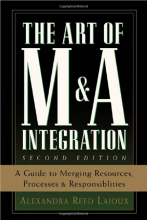Fundamentals of M&A: An Excerpt from The Art of M&A Book Series
By Alexandra Reed Lajoux

How common is it for an acquirer to buy a company because of its brands?
Very common. Virtually every acquisition involves the purchase of at least one product or service with a recognizable name in its market segment. In some cases, the brand may be a “household name” nationwide or even internationally. Companies like these often build brands by imposing their identity (through a visual logo or by sharing a product title, for example) on a series of different products. Indeed, to build the strength of a corporate brand, a company will sometimes rename itself after a brand that it owns through a subsidiary. This is what Consolidated Foods did in 1985, when it successfully renamed itself Sara Lee Corporation after one of its acquired brands.
In some cases, though, acquirers choose not to link their corporate identity with any of the brands they develop or acquire. Maintaining separate brand identities for their subsidiaries gives the acquirer more flexibility should it wish to sell the subsidiaries later. Autonomous brands that do not rely on their parent’s identity can change hands many times over the lifetime of a consumer, and the consumer will notice only the brand, not its changing owners. This brings the valuable element of continuity to the best product brands.
Sometimes after a merger, there is a shift from a corporate identity to a brand identity. DaimlerChrysler did this after its merger. The firm’s brands include Maybach, Mercedes-Benz, Chrysler, Jeep, Dodge, and Smart.
In the United States, communications and dealership signage gave more emphasis to the corporate brand (represented by the Chrysler Pentastar) than to the product brands. Furthermore, most product brands had inconsistent identities across different applications (dealerships, cars, marketing materials, signage).
If brand value is independent of the owner’s identity, why do acquirers have to work to preserve brand identity after a merger? Can’t they just do nothing (so to speak)?
Acquirers need to bear in mind that when they buy a brand, they aren’t just buying a name and a logo. These aspects (technically called a trademark and a service mark) are just the tip of the iceberg. Acquirers of brands buy four things: the brand’s definition (the value it promises), its culture (how the brand’s previous owner has honored the brand’s promise), its infrastructure (internal and external support via advertising, distribution, marketing, promotion, and sales networks), and, finally and most apparently, the visual identity as expressed in the brand’s name and logo. To the extent that any of these elements changes, the brand’s value will change. Also, sometimes an acquiring organization fails to recognize the value of a brand that it is acquiring. As one blogger put it recently, when writing about a “rollup” type acquirer of independent producers of alcoholic beverages, “You can bet your bottom dollar, major brand rationalization will occur, and will occur swiftly. [The acquirer] has a reputation for bean counting and anything that is not profitable or returning an adequate return on investment is given the chop. Many of the boutique brands will go.” 5
How can an acquirer preserve brand identity during the postmerger integration process?
By putting the brand first and integration second. The management of a newly combined company should not say, “Let’s combine our advertising efforts” (or other brand support), thinking that what works for one brand will work for another. This can bury a brand. Instead, managers should say, “Let’s build this brand.” In other words, managers should use integration as a means, not an end. In the process of building a brand, an acquirer should have special reverence for existing names and logos and what they mean to employees and others.
______________________________________________
Lajoux, Alexandra Reed. “Managing Brand Identity After a Merger” The Art of M&A Integration: A Guide to Merging Resources, Processes & Responsibilities. United States of America: McGraw Hill, 2006. Pp. 185-187. Print.
For a complete list of references/notes within this article please call the M&A Leadership Council at 214-689-3800.